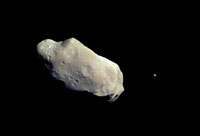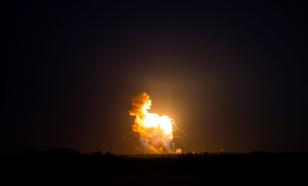Massive asteroid to ram into Mars in 2008
A massive asteroid may slam into Mars at the end of January of 2008. The size of the asteroid can be compared to that of the notorious Tunguska meteorite, U.S. scientists say.

Asteroid 2007 WD5 is expected to hit Mars on January 30, 2008 with odds of impact at 1 in 75. The speed of the asteroid will reach 12.8 km/h. The crater that will be left on Mars after the impact will be similar to the well-known Meteor Crater in the state of Arizona.
If the asteroid slams into Mars, the impact will most likely occur in the equatorial area, where Opportunity rover has been exploring the red planet since 2004.
Astronomers detected Asteroid 2007 WD5 at the end of November 2007. It is currently flying halfway between Earth and Mars.
The above-mentioned Meter Crater in Arizona was created about 50,000 years ago during the Pleistocene epoch when the local climate on the Colorado Plateau was much cooler and damper. At the time, the area was an open grassland dotted with woodlands inhabited by woolly mammoths, giant ground sloths, and camels. It was uninhabited by humans, the first of whom are thought to have reached North America only around 13,000 years ago.
The impact produced a massive explosion equivalent to at least 2.5 megatons of TNT – equivalent to a large thermonuclear explosion and about 150 times the yield of the atomic bombs used at Hiroshima and Nagasaki. The explosion dug out 175 million tons of rock. The shock of impact propagated as a hemispherical shock wave that blasted the rock down and outward from the point of impact, forming the crater. Much more impact energy, equivalent to an estimated 6.5 megatons, was released into the atmosphere and generated a devastating above-ground shockwave.
The Tunguska meteorite, or the Siberian rock, is the largest meteorite explosion in recent history. The mysterious impact occurred in 1908 in Russia’s Siberia.
The explosion was most likely caused by the air burst of a large meteoroid or comet fragment at an altitude of 5 to 10 kilometers (3–6 miles) above Earth's surface. Different studies yielded varying estimates for the meteor's size, including 50 meters, 60 meters, 90 to 190 meters, and up to 1200 meters in diameter. Although the meteor or comet is considered to have burst prior to hitting the surface, this event is still referred to as an impact event. The energy of the blast was estimated to be between 10 and 20 megatons of TNT — 1,000 times more powerful than the bomb dropped on Hiroshima, Japan. The explosion felled an estimated 80 million trees over 2,150 square kilometers (830 sq mi). It is estimated to have measured 5.0 on the Richter scale.
An explosion of this magnitude had the potential to devastate large metropolitan areas had it occurred over a large city. This possibility has helped to spark discussion of asteroid deflection strategies.
Subscribe to Pravda.Ru Telegram channel, Facebook, RSS!


